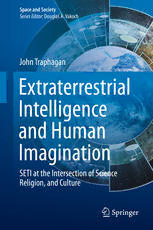
Extraterrestrial Intelligence and Human Imagination: SETI at the Intersection of Science, Religion, and Culture PDF
Preview Extraterrestrial Intelligence and Human Imagination: SETI at the Intersection of Science, Religion, and Culture
Space and Society Series Editor: Douglas A. Vakoch John Traphagan Extraterrestrial Intelligence and Human Imagination SETI at the Intersection of Science, Religion, and Culture Space and Society Series editor Douglas A. Vakoch, SETI Institute, Mountain View, CA, USA and California Institute of Integral Studies, San Francisco, CA, USA More information about this series at h ttp://www.springer.com/series/11929 John Traphagan Extraterrestrial Intelligence and Human Imagination SETI at the Intersection of Science, Religion, and Culture John Traphagan Department of Religious Studies University of Texas at Austin Austin , TX , USA ISSN 2199-3882 ISSN 2199-3890 (electronic) ISBN 978-3-319-10550-5 ISBN 978-3-319-10551-2 (eBook) DOI 10.1007/978-3-319-10551-2 Springer Cham Heidelberg New York Dordrecht London Library of Congress Control Number: 2014950415 © Springer International Publishing Switzerland 2015 T his work is subject to copyright. All rights are reserved by the Publisher, whether the whole or part of the material is concerned, specifi cally the rights of translation, reprinting, reuse of illustrations, recitation, broadcasting, reproduction on microfi lms or in any other physical way, and transmission or information storage and retrieval, electronic adaptation, computer software, or by similar or dissimilar methodology now known or hereafter developed. Exempted from this legal reservation are brief excerpts in connection with reviews or scholarly analysis or material supplied specifi cally for the purpose of being entered and executed on a computer system, for exclusive use by the purchaser of the work. Duplication of this publication or parts thereof is permitted only under the provisions of the Copyright Law of the Publisher’s location, in its current version, and permission for use must always be obtained from Springer. Permissions for use may be obtained through RightsLink at the Copyright Clearance Center. Violations are liable to prosecution under the respective Copyright Law. T he use of general descriptive names, registered names, trademarks, service marks, etc. in this publication does not imply, even in the absence of a specifi c statement, that such names are exempt from the relevant protective laws and regulations and therefore free for general use. While the advice and information in this book are believed to be true and accurate at the date of publication, neither the authors nor the editors nor the publisher can accept any legal responsibility for any errors or omissions that may be made. The publisher makes no warranty, express or implied, with respect to the material contained herein. Printed on acid-free paper Springer is part of Springer Science+Business Media (www.springer.com) For my wife Tomoko Acknowledgments As always, after writing a book there are a number of people who deserve thanks for their willingness to read chapters, discuss ideas, provide editorial assistance, or give ongoing support. The person I must thank fi rst and foremost is my father, who gave me the idea to write this book while we were chatting on the phone one day. We were talking about the course on religion, science, and the search for extrater- restrial intelligence I was teaching at the University of Texas, and he suggested that the basic content of the course would make a great outline for a book. My son, Julian Traphagan, also provided comments on the book, which I much appreciated given his knowledge of and interest in astronomy. I would also like to thank Doug Vakoch, with whom I have had many interesting conversations and who has been quite supportive of my participation in the world of SETI research over the years. My colleagues in the Department of Religious Studies at the University of Texas also deserve my appreciation for the wonderfully collegial environment they create on a daily basis and their patient tolerance for an odd anthropologist with interests in aliens who sits among them. The ongoing help of my research assistant, Katherine Sanchez, has been greatly appreciated. A quick email with a question usually ends up with a fl ood of articles. Earlier versions of chapters four and fi ve were published in Douglas Vakoch’s edited volume A rchaeology, Anthropology, and Interstellar Communication , which is part of the NASA History Series (2014). I am grateful for NASA publishing my earlier work and allowing me to reuse the material in signifi cantly altered form for this book. Finally, of course, I must thank my wife Tomoko, son Julian, and daughter Sarah, who are always a source of strength and love. vii Contents 1 Thinking About Religion and Science ..................................................... 1 1.1 Foundations for Thinking About SETI: Some Ideas and Assumptions ............................................................ 3 1.2 Science and Religion ......................................................................... 5 2 A Brief History of Thinking About ETI.................................................. 17 2.1 Narrowing Imagination ...................................................................... 18 2.2 Expanding Imagination ...................................................................... 22 2.3 Imagining Aliens ............................................................................... 27 2.4 It Came From Outer Space ................................................................ 29 2.5 It Came from Earth, Too .................................................................... 32 3 Are We Alone? The Emergence of SETI ................................................ 35 3.1 Leaving Earth ..................................................................................... 36 3.2 ETI in the Scientifi c Imagination: The Drake Equation .................... 40 3.3 Civilization? ....................................................................................... 44 4 Culture, Intelligence, and ETI ................................................................ 53 4.1 What Is Culture? ................................................................................ 58 4.2 Implications for SETI Research ......................................................... 65 4.3 The Star Trek Imaginary .................................................................... 68 4.4 Symbols and Meaning ....................................................................... 70 5 Knowledge Production in the Encounter with Alien Others ................. 73 5.1 Ruth Benedict and the Invention of Japanese Culture ....................... 76 5.2 Implications of Anthropology at a Distance for SETI ....................... 80 5.3 New Imaginaries ................................................................................ 84 ix
